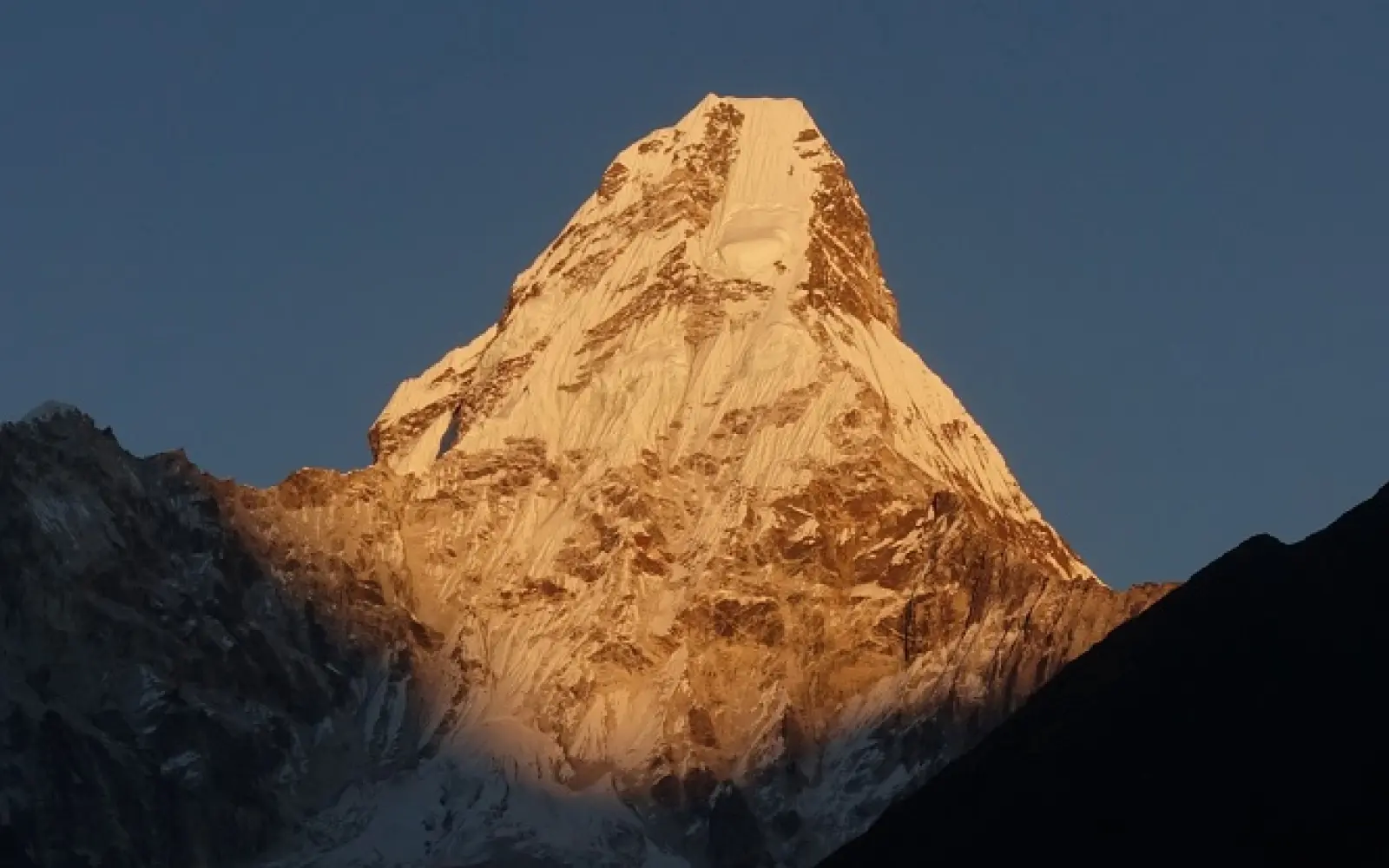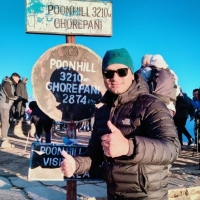


Actually, one of the world's most famous treks is the Everest Base Camp Trek. Moreover, it is one of the ten best treks in Nepal and also popular as one of the ten best places to visit in Nepal. It takes you right to the Himalayan heart. The trek starts at Lukla, 2,860 meters above sea level. You trek via Sherpa villages and stunning valleys from here.
Also, along the way, you go through Namche Bazaar (3,440m), Tengboche (3,860m), and Dingboche (4,410m). These are significant stops to acclimate and witness local life. Later, you move up to Lobuche (4,940m) and Gorakshep (5,164m).
Similarly, the main highlight of EBC Trek is to arrive at Everest Base Camp at 5,364 meters. From here, you witness breathtaking views of Everest (8,848.86m) and surrounding peaks. Close by Kala Patthar (5,545m) is the finest panoramic viewpoint of the mountain.
Likewise, the Everest Base Camp trek encompasses Buddhist monasteries, prayer flags, and breathtaking scenery. The blend of nature and culture is what renders it unique. Trekking permits like Sagarmatha National Park Entry and TIMS are required for the trek.
Therefore, Everest Base Camp trek is suitable for those trekkers who would wish to view high mountains and Sherpa culture. It typically lasts from 12 to 14 days to complete safely. Physical condition and preparation need to be fine.
In short, Everest Base Camp Trek is a life-enriching Himalayan adventure. It contains challenging trails, stunning landscapes, and cultural richness.
Actually, the best time for Everest Base Camp Trek is Spring and Autumn. These seasons provide good weather and pleasant temperatures. Trekkers enjoy excellent views of Everest (8,848.86m) and neighboring peaks.
Also, in Spring, from March to May, rhododendron forests are flowering. The days are warm and nights are cool. The season shows beautiful colorful landscape.
Similarly, Autumn, from September to November, follows the monsoon. The weather becomes clear and the air is refreshing. The temperatures are mild and the trails are dry.
Unlike Summer or Winter, these seasons avoid heavy rains or harsh cold. Monsoon rains make trails slippery. Winter brings snow and freezing temperatures above 4,000 meters.
So, plan your EBC Trek trek during Spring or Autumn for comfort and safety. These seasons also coincide with important trekking festivals and events.
In short, the best time for EBC Trek is Spring or Autumn. These seasons offer the best Himalayan views and perfect trekking weather.

Autumn is indeed the busiest season for Everest Base Camp Trek. Weather remains stable and dry, providing excellent trekking conditions. Blue skies provide stunning mountain vistas.
Similarly, temperatures in Namche Bazaar (3,440m) remain around 12°C by day. Nights at Gorakshep (5,164m) can get down to -10°C, so it's necessary to have warm gear. The air is crisp and cool.
Also, the path is full of trekkers from all over the world during Autumn. Tea houses are open and well-stocked. Sherpa festivals like Mani Rimdu at Tengboche add to cultural experiences.
However, popularity also means flights and accommodations getting booked up fast. Advance booking is necessary to secure your spot. But the locals' warm hospitality doesn't change.
In short, Autumn offers the perfect combination of weather, landscape, and culture. It is a great time for Everest Base Camp Trekking.
September marks the start of the Autumn season for Everest trekking. The monsoon leaves early in the month. The trails dry quickly, and the visibility improves a lot.
Actually, temperatures are pleasant in lower elevations like Namche Bazaar (3,440m). Day temperatures reach up to about 14°C. Nights become cold but manageable with proper warm clothing.
Also, green valleys and new scenery brighten up the EBC trek route. Rivers bloat with monsoon discharge. Views of Everest (8,848.86m) and Lhotse (8,516m) improve as clouds clear.
However, early September may still witness occasional showers. Waterproof gear is required for safety. Trails are less crowded in comparison to peak months.
In summary, September usher s in freshness, fewer hikers, and improving weather. September is a recommended time for the Everest Base Camp Trek.
October is the best month for Everest Base Camp Trek. The weather is dry, stable, and clear. The skies are blue, and breathtaking mountain views are feasible.
Actually, the temperatures in Namche Bazaar (3,440m) in October range from 10°C to 0°C. In higher elevations like Gorakshep (5,164m), it can drop below -10°C. Despite this, there are sunny days that provide comfortable trekking.
Furthermore, October receives many trekkers from all over the world along Everest Base Camp Route. The EBC trail is busy, and tea houses are crowded. Tengboche Monastery conducts the Mani Rimdu Festival, which adds cultural depth.
Likewise, flights to Lukla run smoothly because of the stable weather conditions. One needs to reserve flights and lodges in advance owing to the high demand. Planning ahead guarantees a smooth trip.
In brief, October is the ideal time for Everest Base Camp Trek. It is a combination of perfect weather, vibrant culture, and scenery.
November offers a peaceful and dry trek. It is technically the last month of the Autumn season. The skies still remain clear, offering stunning Himalayan views.
Temperatures start to drop, especially above 4,000 meters. In Lobuche (4,940m), nights temperature in November reach -15°C. However, daytime temperatures are warm and sunny.
Also, the EBC trail in November gets fewer trekkers compared to October. Tea houses remain open, and Sherpa hospitality is warm. This makes for trekking that is serene and enjoyable.
However, cold weather calls for layering and winter gear. Kala Patthar sunrise views (5,545m) are magical during this period. Early mornings are quite cold.
Briefly, November is ideal for trekkers for Everest Base Camp Trek seeking clear skies and fewer people. It offers a peaceful yet spectacular journey.
The other best time for Everest Base Camp Trek is during spring. It's a season of warm days and blooming flowers. The trails are filled with color and life.
Actually, March to May provide stable weather and clear visibility. Rhododendron forests bloom on the lower trails. Day temperature at Tengboche (3,860m) averages 10°C.
Besides that, the views of Everest (8,848.86m), Lhotse (8,516m), and Ama Dablam (6,812m) are crystal clear. The snowline begins to retreat. Trekking is festive and vibrant.
Likewise, Everest climbers also begin climbing in late April and May. Trekkers can meet climbers at Everest Base Camp (5,364m). The area is vibrant with energy and activity.
In short, EBC Trek in Spring is a colorful, clear, and comfortable trekking season. It is a perfect time for the Everest Base Camp Trek.

March marks the beginning of Spring season in the Everest region. Actually, it is an ideal time to start your trek. The weather starts warming up gradually.
Also, temperatures during the day in March at Namche Bazaar (3,440m) rise to about 8°C. At higher altitudes like Lobuche (4,940m), temperatures remain at about -8°C. The weather improves and the views become better.
At the same time, rhododendrons begin blooming along the EBC Trekking route in March. Forests are vibrant and fresh. Trails are not busy, offering peaceful trekking.
Moreover, there is still snow on higher sections of the trail. You need sturdy boots and warm clothing. Early spring is the best for those who want solitude and beauty.
In brief, March is a refreshing month to undertake Everest Base Camp Trek. It provides calm trails and improved weather.
April is among the most popular months for Everest Base Camp Trek. In fact, the weather is dry and stable. Skies are mostly clear, which is great for hiking.
Additionally, temperatures are ideal for Everest Base Camp trekking in April. Tengboche (3,860m) experiences day time averages of 12°C. Nights at Gorakshep (5,164m) may even go as low as -10°C, so one has to wear warm clothing.
Rhododendron forests are in bloom. Trails become colorful and lively. Views of Everest (8,848.86m) and Ama Dablam (6,812m) are stunning.
Likewise, several climbers trek to Everest Base Camp in April. Base camp is crowded with expedition teams. It offers a lively environment.
Therefore, April is beautiful, has clear skies, and ideal trekking conditions. It's one of the best times to undertake the EBC Trek.
May is the end of Spring trekking season in Everest region. Indeed, it's also Everest climbing season. The base camp bursts with activity from expeditions.
Actully, lower elevations get warmer during May along Everest Base Camp Trek route. Namche Bazaar (3,440m) gets about 15°C during the day. Even Gorakshep (5,164m) is less cold.
Also, skies continue to be generally clear. Lhotse (8,516m) and Nuptse (7,861m) climbs are still spectacular. Melting snow clears the way easily.
But haze can develop in late May. So an early start is advisable. Trails become more crowded towards the latter half of the month.
In brief, May is colorful, scenic, and vibrant. May is a rewarding time for the Everest Base Camp Trek.
Proper preparation is really the key to a successful Everest Base Camp trek. You must build good physical fitness and endurance. The trek brings you to 5,364 meters, which requires endurance.
In addition, make your trekking permits ahead of time. Acclimatization days in EBC Trek are needed for safety. Psychological readiness is also important for the challenge.
The following are some recommendations by Haven Holidays Team on how to prepare for EBC Trek:
Thus, good preparation enhances safety and comfort during Everest Base Camp Trek. It also increases your confidence on the trail.
In short, physical, mental, and logistical readiness makes the journey hassle-free. Prepare well for your Everest Base Camp trek.

Proper packing is very important on this high-altitude trek like Everest Base Camp Trek. Weather can change rapidly, so pack accordingly. Keep your backpack light but loaded.
Additionally, layer up and stay warm all round the Everest Base Camp Trek. Choose lightweight, quick-drying clothing. Wear warm clothes for cold nights and sunny days.
The following are 30 essentials to pack for Everest Base Camp Trek:
1. Trekking boots
2. Sandals
3. Four pairs of trekking socks
4. Two thermal base layers
5. Two fleece jackets
6. Down jacket
7. Windproof outer shell
8. Two trekking pants
9. One insulated pants
10. Waterproof pants
11. Three trekking shirts
12. Sun hat
13. Woolen hat
14. Buff or neck gaiter
15. Sunglasses (UV protection)
16. Gloves (light and warm)
17. Sleeping bag (-10°C rating)
18. Backpack (40-50 liters)
19. Daypack (20 liters)
20. Headlamp with extra batteries
21. Hydration bladder or water bottles
22. Water purification tablets
23. Sunscreen with SPF 50+
24. Lip balm with SPF
25. Toiletries
26. Small towel
27. Quick-dry underwear
28. First aid kit
29. Altitude medication
30. Snacks and energy bars
In short, pack smart to be comfortable and safe during your Everest Base Camp Trek. Good equipment is the secret to an enjoyable Everest Base Camp Trek.
In reality, choosing best time makes Everest Base Camp Trek successful. Good timing affects your safety and experience. Spring and Autumn are the most suitable seasons for Everest Base Camp Trek.
Additionally, Spring (March to May) is warm with rhododendrons blooming. Views of Everest (8,848.86m) remain clear. The trail remains colorful and alive.
Likewise, Autumn (September-November) is post-monsoon. Skies clear, and one enjoys wonderful vistas of ridges like Lhotse (8,516m) and Ama Dablam (6,812m). Weather is dry and settled.
Off-season Everest treks have heavy rain or snow unlike Summer or Winter. Monsoon rains make trails slippery. Winter has freezing weather and delayed flights.
So, choose Spring or Autumn with better weather for your EBC Trek. Book flights and accommodation in advance. Bring appropriate gear and train rigorously.
Overall, the best time for EBC Trek depends on the weather and visibility. Proper planning guarantees a safe and memorable Himalayan experience.

